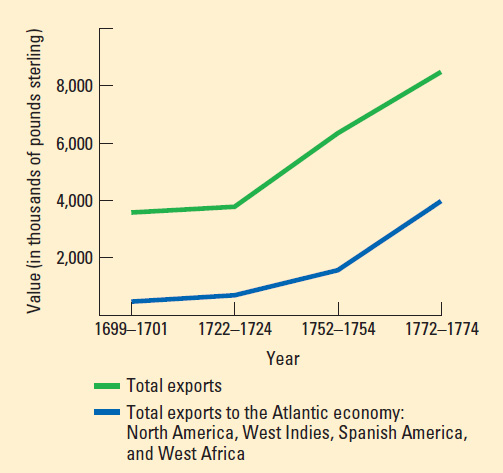A History of Western Society: Printed Page 560
A History of Western Society, Value Edition: Printed Page 570
The Atlantic Economy
As the volume of transatlantic trade increased, the regions bordering the ocean were increasingly drawn into an integrated economic system. Commercial exchange in the Atlantic has traditionally been referred to as the “triangle trade,” designating a three-way transport of goods: European commodities, like guns and textiles, to Africa; enslaved Africans to the colonies; and colonial goods, such as cotton, tobacco, and sugar, back to Europe (see Map 17.2).

Across the eighteenth century the economies of European nations bordering the Atlantic Ocean, especially England, relied more and more on colonial exports. In England, sales to the mainland colonies of North America and the West Indian sugar islands — with an important assist from West Africa and Latin America — soared from £500,000 to £4 million (Figure 17.3). Exports to England’s colonies in Ireland and India also rose substantially from 1700 to 1800. By 1800 sales to European countries — England’s traditional trading partners — represented only half of exports, down from three-quarters a century earlier. England also benefited from importing colonial products. Colonial monopolies allowed the English to obtain a steady supply of such goods at beneficial prices and to re-export them to other nations at high profits. Moreover, many colonial goods, like sugar and tobacco, required processing before consumption and thus contributed new manufacturing jobs in England. In the eighteenth century, stimulated by trade and empire building, England’s capital city, London, grew into the West’s largest and richest city. (See “Living in the Past: The Remaking of London.”) Thus the mercantilist system achieved remarkable success for England, and by the 1770s the country stood on the threshold of the epoch-making changes that would become known as the Industrial Revolution.
Although they lost many possessions to the English in the Seven Years’ War, the French still profited enormously from colonial trade. The colonies of Saint-Domingue (modern-day Haiti), Martinique, and Guadeloupe remained in French hands and provided immense fortunes in plantation agriculture and slave trading during the second half of the eighteenth century. By 1789 the population of Saint-Domingue included five hundred thousand slaves whose labor had allowed the colony to become the world’s leading producer of coffee and sugar and the most profitable plantation colony in the New World.12 The wealth generated from colonial trade fostered the confidence of the merchant classes in Paris, Bordeaux, and other large cities, and merchants soon joined other elite groups clamoring for political reforms.
The third major player in the Atlantic economy, Spain, also saw its colonial fortunes improve during the eighteenth century. Not only did it gain Louisiana from France in 1763, but its influence expanded westward all the way to northern California through the efforts of Spanish missionaries and ranchers. Its mercantilist goals were boosted by a recovery in silver production, which had dropped significantly in the seventeenth century.
Silver mining also stimulated food production for the mining camps, and wealthy Spanish landowners developed a system of debt peonage to keep indigenous workers on their estates. Under this system, which was similar to serfdom, a planter or rancher would keep workers in perpetual debt bondage by advancing them food, shelter, and a little money.
Although the “triangle trade” model highlights some of the most important flows of commerce across the Atlantic, it significantly oversimplifies the picture. For example, a brisk intercolonial trade also existed, with the Caribbean slave colonies importing food in the form of fish, flour, and livestock from the northern colonies and rice from the south, in exchange for sugar and slaves (see Map 17.2). Many colonial traders violated imperial monopolies to trade with the most profitable partners, regardless of nationality. Moreover, the Atlantic economy was inextricably linked to trade with the Indian and Pacific Oceans (see page 570).